Density-Driven CO2 Dissolution in Depleted Gas Reservoirs with Bottom Aquifers
Abstract
:1. Introduction
2. Materials and Methods
2.1. Conservation Equations
2.2. Thermodynamic Model
2.3. Numerical Model and Characteristic Parameters
3. Results
3.1. Effect of the Capillary Transition Zone
3.1.1. CO2 Dissolution Rate
3.1.2. Sherwood Number
3.2. Effect of Residual Natural Gas Concentration
3.2.1. CO2 Dissolution Rate
3.2.2. Sherwood Number
3.2.3. Density Difference and Saturation Profile
3.2.4. Onset Time and Decay Time
3.3. Field-Scale Simulation for CO2 Injection and Storage
3.3.1. CO2 Injection Period
3.3.2. CO2 Post-Injection Period
4. Conclusions
- [1]
- The stagnant capillary zone significantly disrupts the concentration boundary layer, enhancing solubility trapping. This is evidenced by higher Sherwood numbers and maximum values in two-phase simulations compared to single-phase ones, indicating stronger convection due to the capillary zone;
- [2]
- The increased residual natural gas concentration lowers the CO2 partial pressure and solubility, reducing the density contrast between ambient and CO2-enriched brine and weakening convective mass transport. In addition, changes in gas composition alter the saturation profile in the capillary zone, further reducing the intensity of perturbations. These combined effects significantly hinder mass transport, leading to lower dissolution rates and Sherwood numbers;
- [3]
- The onset and decay times of mass transfer processes have an exponential relationship with residual natural gas concentration, highlighting the increasing impact of gas mixtures with higher residual gas levels;
- [4]
- The effective cumulative gas production increased by 16.71 × 106 m3, marking an 18.9% increase compared to depletion development. However, the presence of CH4 significantly reduces the amount of CO2 dissolution.
Author Contributions
Funding
Data Availability Statement
Conflicts of Interest
References
- Bachu, S. CO2 storage in geological media: Role, means, status and barriers to deployment. Prog. Energy Combust. Sci. 2008, 34, 254–273. [Google Scholar] [CrossRef]
- Benson, S.M.; Cole, D.R. CO2 sequestration in deep sedimentary formations. Elements 2008, 4, 325–331. [Google Scholar] [CrossRef]
- Shukla, R.; Ranjith, P.; Haque, A.; Choi, X. A review of studies on CO2 sequestration and caprock integrity. Fuel 2010, 89, 2651–2664. [Google Scholar] [CrossRef]
- Bachu, S.; Shaw, C.; Pearson, R.M. Estimation of oil recovery and CO2 storage capacity in CO2 EOR incorporating the effect of underlying aquifers. In Proceedings of the SPE lmproved Oil Recovery Conference, Tulsa, OK, USA, 18–22 April 2004; p. SPE-89340. [Google Scholar] [CrossRef]
- Wang, F.; Xu, H.; Liu, Y.; Meng, X.; Liu, L. Mechanism of Low Chemical Agent Adsorption by High Pressure for Hydraulic Fracturing-Assisted Oil Displacement Technology: A Study of Molecular Dynamics Combined with Laboratory Experiments. Langmuir 2023, 39, 16628–16636. [Google Scholar] [CrossRef] [PubMed]
- Lyu, X.; Voskov, D.; Rossen, W.R. Numerical investigations of foam-assisted CO2 storage in saline aquifers. Int. J. Greenh. Gas Control 2021, 108, 103314. [Google Scholar] [CrossRef]
- Zhang, C.; Wang, E.; Li, B.; Kong, X.; Xu, J.; Peng, S.; Chen, Y. Laboratory experiments of CO2-enhanced coalbed methane recovery considering CO2 sequestration in a coal seam. Energy 2023, 262, 125473. [Google Scholar] [CrossRef]
- Mohagheghian, E.; Hassanzadeh, H.; Chen, Z. CO2 sequestration coupled with enhanced gas recovery in shale gas reservoirs. J. CO2 Util. 2019, 34, 646–655. [Google Scholar] [CrossRef]
- Li, Z.; Dong, M.; Li, S.; Huang, S. CO2 sequestration in depleted oil and gas reservoirs-caprock characterization and storage capacity. Energy Convers. Manag. 2006, 47, 1372–1382. [Google Scholar] [CrossRef]
- Gilfillan, S.M.; Lollar, B.S.; Holland, G.; Blagbumm, D.; Stevens, S.; Schoell, M.; Cassidy, M.; Ding, Z.; Zhou, Z.; Lacrampe-Couloume, G.; et al. Solubility trapping in formation water as dominant CO2 sink in natural gas felds. Nature 2009, 458, 614–618. [Google Scholar] [CrossRef]
- Abba, M.K.; Abbas, A.J.; Nasr, G.G.; Al-Otaibi, A.; Burby, M.; Saidu, B.; Suleiman, S.M. Solubility trapping asa potential secondary mechanism for CO2 sequestration during enhanced gas recovery by CO2 injection in conventional natural gas reservoirs: An experimental approach. J. Nat. Gas Sci. Eng. 2019, 71, 103002. [Google Scholar] [CrossRef]
- Zhang, X.; Wei, B.; Shang, J.; Gao, K.; Pu, W.; Xu, X.; Wood, C.; Sun, L. Alterations of geochemical properties of a tight sandstone reservoir caused by supercritical co2-brine-rock interactions in CO2-EOR and geosequestration. J. CO2 Util. 2018, 28, 408–418. [Google Scholar] [CrossRef]
- Al-Khdheeawi, E.A.; Vialle, S.; Barifcani, A.; Sarmadivaleh, M.; Iglauer, S. impact of reservoir wettability and heterogeneity on CO2-plume migration and trapping capacity. Int. J. Greenh. Gas Control 2017, 58, 142–158. [Google Scholar] [CrossRef]
- Wen, G.; Benson, S.M. CO2 plume migration and dissolution in layered reservoirs. Int. J. Greenh. Gas Control 2019, 87, 66–79. [Google Scholar] [CrossRef]
- Menad, N.A.; Hemmati-Sarapardeh, A.; Varamesh, A.; Shamshirband, S. Predicting solubility of CO2 in brine by advanced machine learning systems: Application to carbon capture and sequestration. J. CO2 Util. 2019, 33, 83–95. [Google Scholar] [CrossRef]
- Soltanian, M.R.; Amooie, M.A.; Gershenzon, N.; Dai, Z.; Ritzi, R.; Xiong, F.; Cole, D.; Moortgat, J. Dissolution trapping of carbon dioxide in heterogeneous aquifers. Environ. Sci. Technol. 2017, 51, 7732–7741. [Google Scholar] [CrossRef] [PubMed]
- Cui, G.; Wang, Y.; Rui, Z.; Chen, B.; Ren, S.; Zhang, L. Assessing the combined influence of fluid-rock interaction reservoir properties and injectivity during CO2 storage in saline aquifers. Energy 2018, 155, 281–296. [Google Scholar] [CrossRef]
- Tremosa, I.; Castillo, C.; Vong, C.O.; Kervévan, C.; Lassin, A.; Audigane, P. Long-term assessment of geochemical reactivity of CO2 storage in highly saline aquifers: Application to ketzin, in salah and snohvit storage sites. Int. J. Greenh. Gas Control 2014, 20, 2–26. [Google Scholar] [CrossRef]
- Kim, M.; Kim, K.-Y.; Han, W.S.; Oh, J.; Park, E. Density-driven convection in a fractured porous media: Implications for geological CO2 storage. Water Resour. Res. 2019, 55, 5852–5870. [Google Scholar] [CrossRef]
- Chang, C.; Kneafsey, T.J.; Wan, J.; Tokunaga, T.K.; Nakagawa, S. Impacts of mixed-wettability on brine drainage and supercritical CO2 storage efficiency in a 2.5-d heterogeneous micromodel. Water Resour. Res. 2020, 56, e2019WR026789. [Google Scholar] [CrossRef]
- Wang, Y.; Vuik, C.; Hajibeygi, H. Analysis of hydrodynamic trapping interactions during full-cycle injection and migration of CO2 in deep saline aquifers. Adv. Water Resour. 2022, 159, 104073. [Google Scholar] [CrossRef]
- Ranganathan, P.; Farajzadeh, R.; Bruining, H.; Zitha, P.L. Numerical simulation of natural convection in hetero-geneous porous media for CO2 geological storage. Transp. Porous Media 2012, 95, 25–54. [Google Scholar] [CrossRef]
- Kong, X.-Z.; Saar, M.O. Numerical study of the effects of permeability heterogeneity on density-driven convective mixing during CO2 dissolution storage. Int. J. Greenh. Gas Control 2013, 19, 160–173. [Google Scholar] [CrossRef]
- Mahyapour, R.; Mahmoodpour, S.; Singh, M.; Omrani, S. Effect of permeability heterogeneity on the dissolution process during carbon dioxide sequestration in saline aquifers: Two-and three-dimensional structures. Geomech. Geophys. Geo-Energy Geo-Resour. 2022, 8, 70. [Google Scholar] [CrossRef]
- Ajayi, T.; Gomes, J.S.; Bera, A. A review of CO2 storage in geological formations emphasizing modeling. monitoring and capacity estimation approaches. Pet. Sci. 2019, 16, 1028–1063. [Google Scholar] [CrossRef]
- Lyu, X.; Khait, M.; Voskov, D. Operator-based linearization approach for modeling of multiphase flow with buoyancy and capillarity. SPE J. 2021, 26, 1858–1875. [Google Scholar] [CrossRef]
- Hussein, A.; Hussein, I.A.; Al-Marri, M.; Mahmoud, M.; Shawabkeh, R.; Aparicio, S. CO2 enhanced gas recover and sequestration in depleted gas reservoirs: A review. J. Pet. Sci. Eng. 2021, 196, 107685. [Google Scholar]
- Shen, X.; Liu, H.; Mu, L.; Lyu, X.; Zhang, Y.; Zhang, W. A semi-analytical model for multi-well leakage in adepleted gas reservoir with irregular boundaries. Gas Sci. Eng. 2023, 114, 204979. [Google Scholar] [CrossRef]
- Yuan, S.L.L.; Liu, W.; Zhao, C.; Zhang, Y.; Song, Y. Study on the influence of various factors on dispersion during enhance natural gas recovery with co2 sequestration in depleted gas reservoir. J. Nat. Gas Sci. Eng. 2022, 103, 104644. [Google Scholar]
- Mu, L.; Liao, X.; Zhao, X.; Chen, Z.; Zhu, L.; Luo, B. Numerical analyses of the effect of the impurity in the gas on the solubility trapping in the CO2 sequestration. In Proceedings of the Carbon Management Technology Conference, CMTC2017, Houston, TX, USA, 17–20 July 2017; p. CMTC-486524. [Google Scholar] [CrossRef]
- Li, D.; Jiang, X. Numerical investigation of convective mixing in impure CO2 geological storage into deep saline aquifers. Int. J. Greenh. Gas Control 2020, 96, 103015. [Google Scholar] [CrossRef]
- Mahmoodpour, S.; Amooie, M.A.; Rostami, B.; Bahrami, F. Effect of gas impurity on the convective dissolution of CO2 in porous media. Energy 2020, 199, 117397. [Google Scholar] [CrossRef]
- Spycher, N.; Pruess, K.; Ennis-King, J. CO2-H2O mixtures in the geological sequestration of CO2. I. Assessment and calculation of mutual solubilities from 12 to 100 °C and up to 600 bar. Geochim. Cosmochim. Acta 2003, 67, 3015–3031. [Google Scholar] [CrossRef]
- Islam, A.W.; Carlson, E.S. Viscosity Models and Effects of Dissolved CO2. Energy Fuels 2012, 26, 5330–5336. [Google Scholar] [CrossRef]
- Elenius, M.T.; Voskov, D.V.; Tchelepi, H.A. Interactions between gravity currents and convective dissolution. Adv. Water Resour. 2015, 83, 77–88. [Google Scholar] [CrossRef]
- Spivey, J.P.; McCain, W.D., Jr. Estimating Density, Formation Volume Factor, Compressibility, Methane Solubility, and Viscosity for Oilfield Brines at Temperatures From 0 to 275 °C, Pressures to 200 MPa, and Salinities to 5.7 mole/kg; Technical Report; Schlumberger-Beijing Science Centre: Houston, TX, USA, 2004. [Google Scholar] [CrossRef]
- Mao, S.; Duan, Z. The viscosity of aqueous alkali-chloride solutions up to 623 K, 1000 bar, and high ionic strength. Int. J. Thermophys. 2009, 30, 1510–1523. [Google Scholar] [CrossRef]
- Brooks, R. and Corey, T. Hydraulic Properties of Porous Media; Hydrology Papers; Colorado State University: Fort Collins, CO, USA, 1964; 24:37. 18 of 25. [Google Scholar]
- Pau, G.S.; Bell, J.B.; Pruess, K.; Almgren, A.S.; Lijewski, M.J.; Zhang, K. High-resolution simulation and characterization of density-driven flow in CO2 storage in saline aquifers. Adv. Water Resour. 2010, 33, 443–455. [Google Scholar] [CrossRef]
- Khait, M.; Voskov, D. Adaptive parameterization for solving of thermal/compositional nonlinear flow and trans-port with buoyancy. SPE J. 2018, 23, 522–534. [Google Scholar] [CrossRef]
- Wang, Y.; Voskov, D.; Khait, M.; Bruhn, D. An efficient numerical simulator for geothermal simulation: Abenchmark study. Appl. Energy 2020, 264, 114693. [Google Scholar] [CrossRef]
- Voskov, D. Operator-based linearization approach for modeling of multiphase multi-component flow in porous media. J. Comput. Phys. 2017, 337, 275–288. [Google Scholar] [CrossRef]
- Elenius, T.; Nordbotten, J.M.; Kalisch, H. Convective mixing influenced by the capillary transition zone. Comput. Geosci. 2014, 18, 417–431. [Google Scholar] [CrossRef]
- Lyu, X.; Voskov, D. Advanced modeling of enhanced CO2 dissolution trapping in saline aquifers. Int. J. Greenh. Gas Control 2023, 127, 103907. [Google Scholar] [CrossRef]

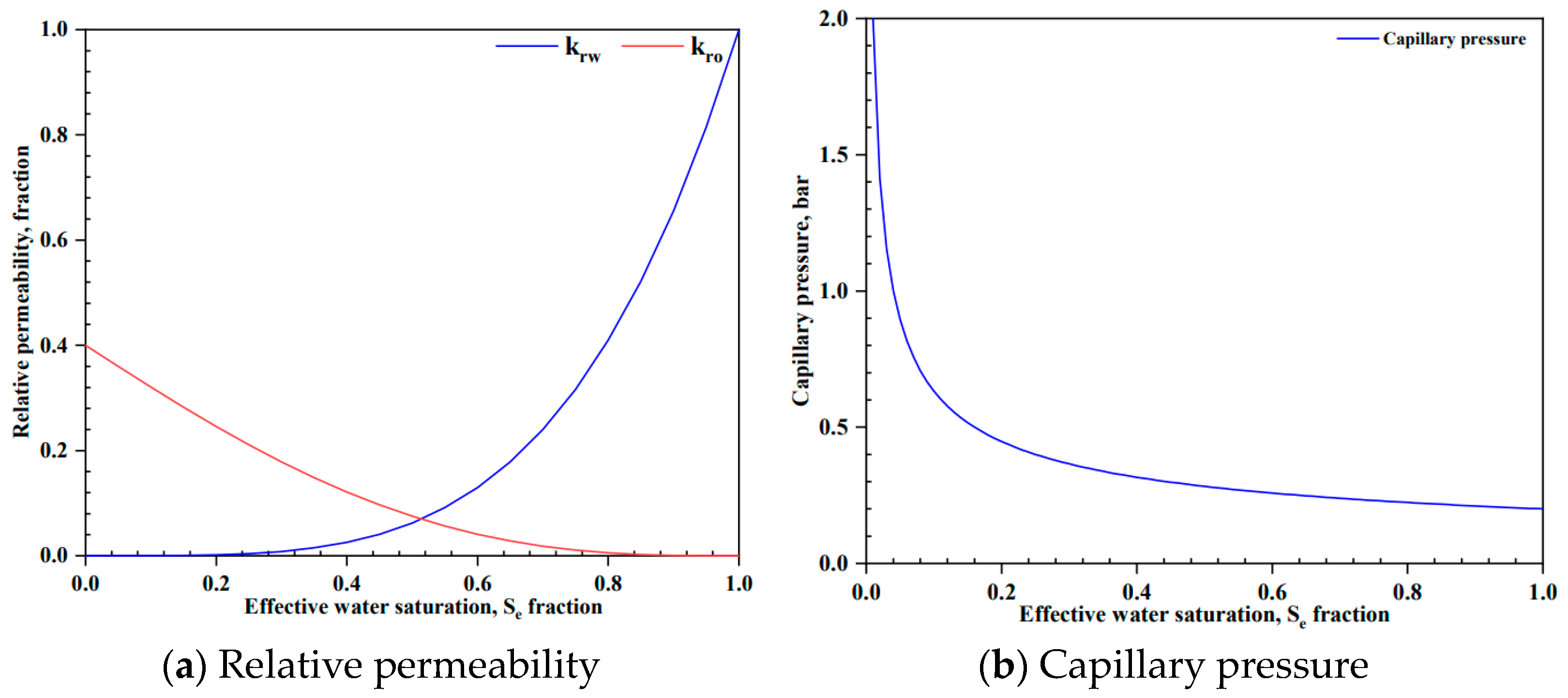
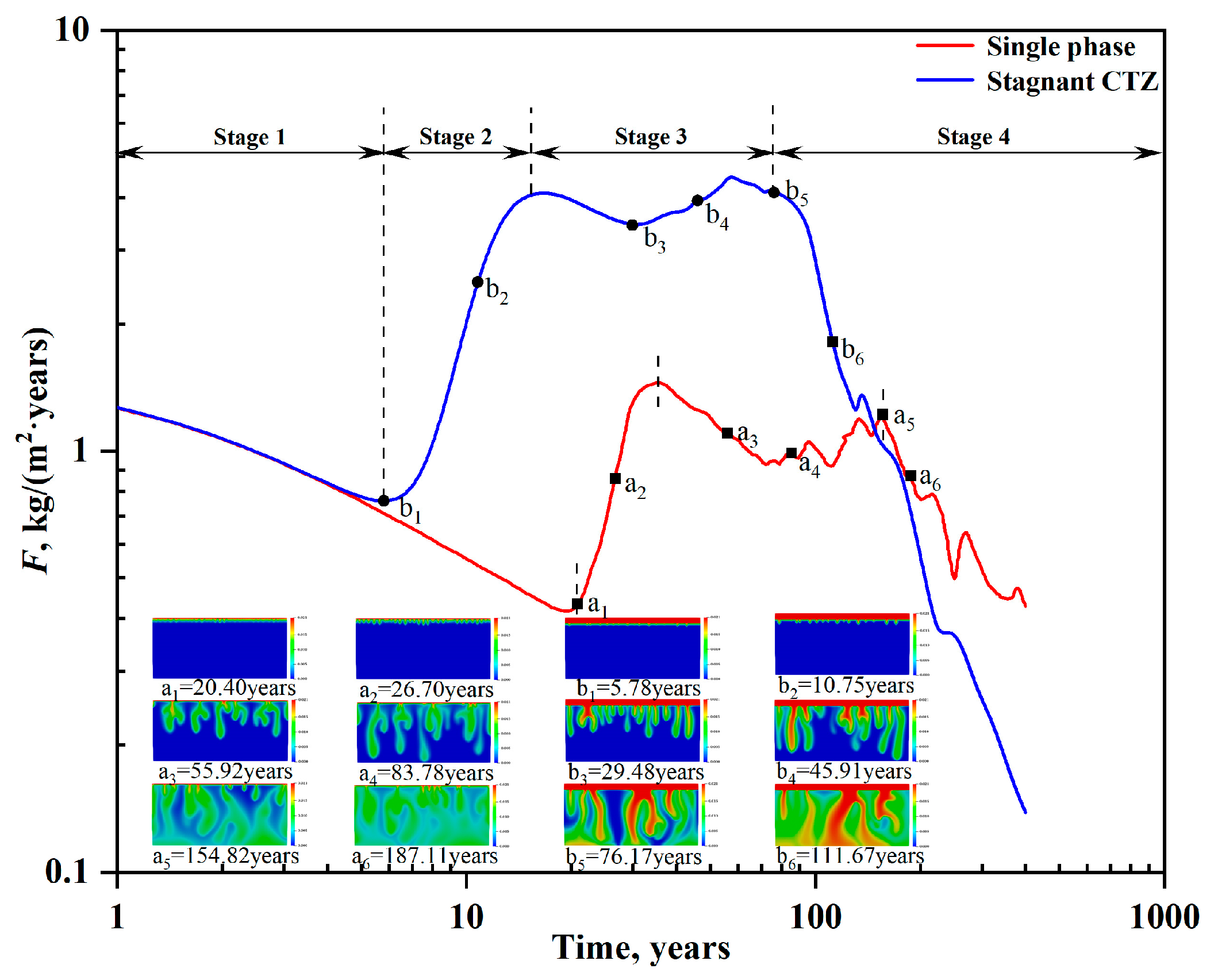
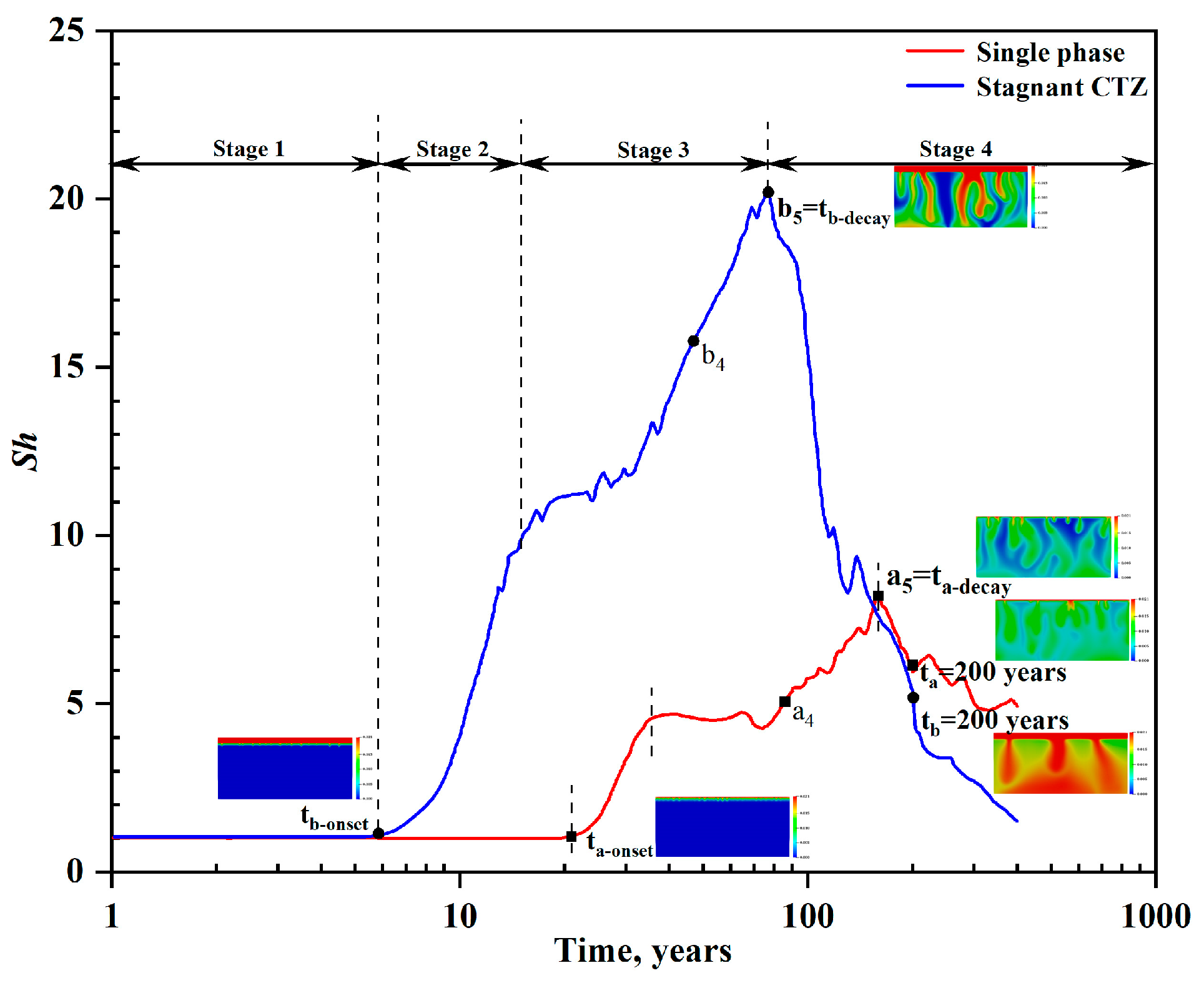


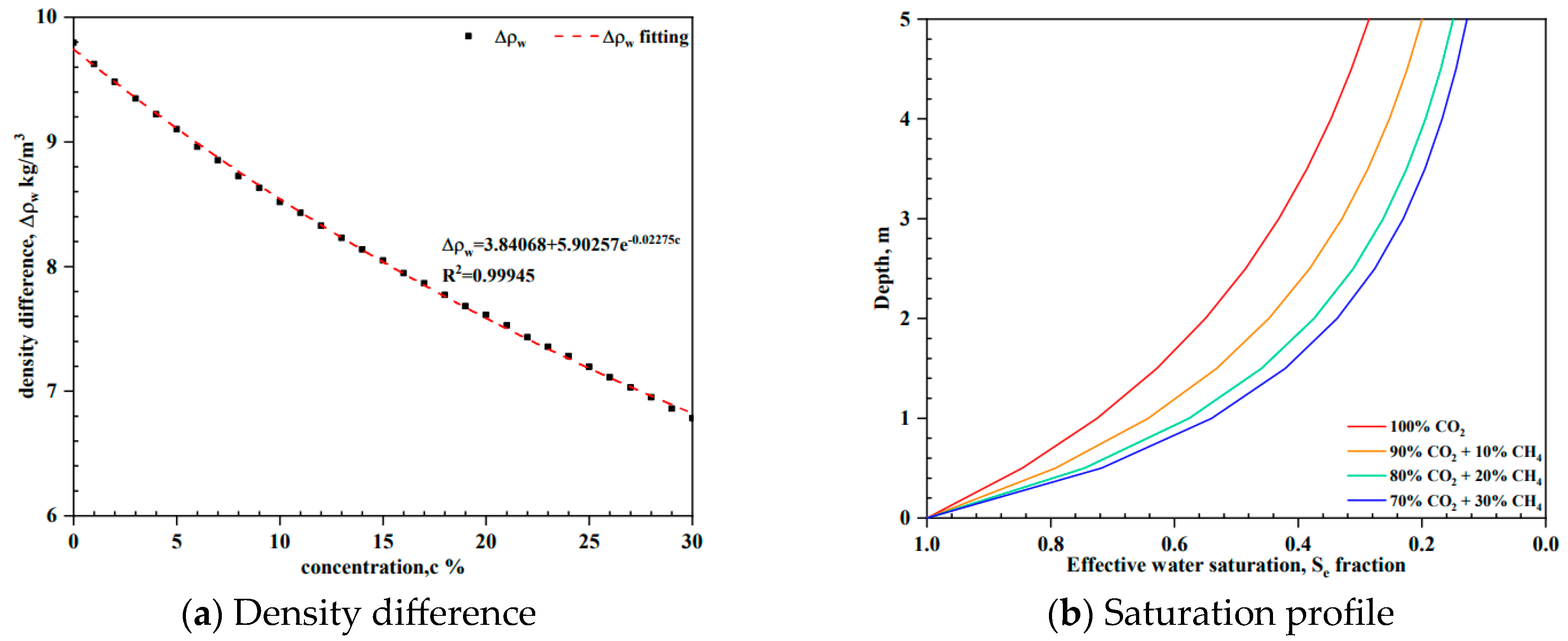
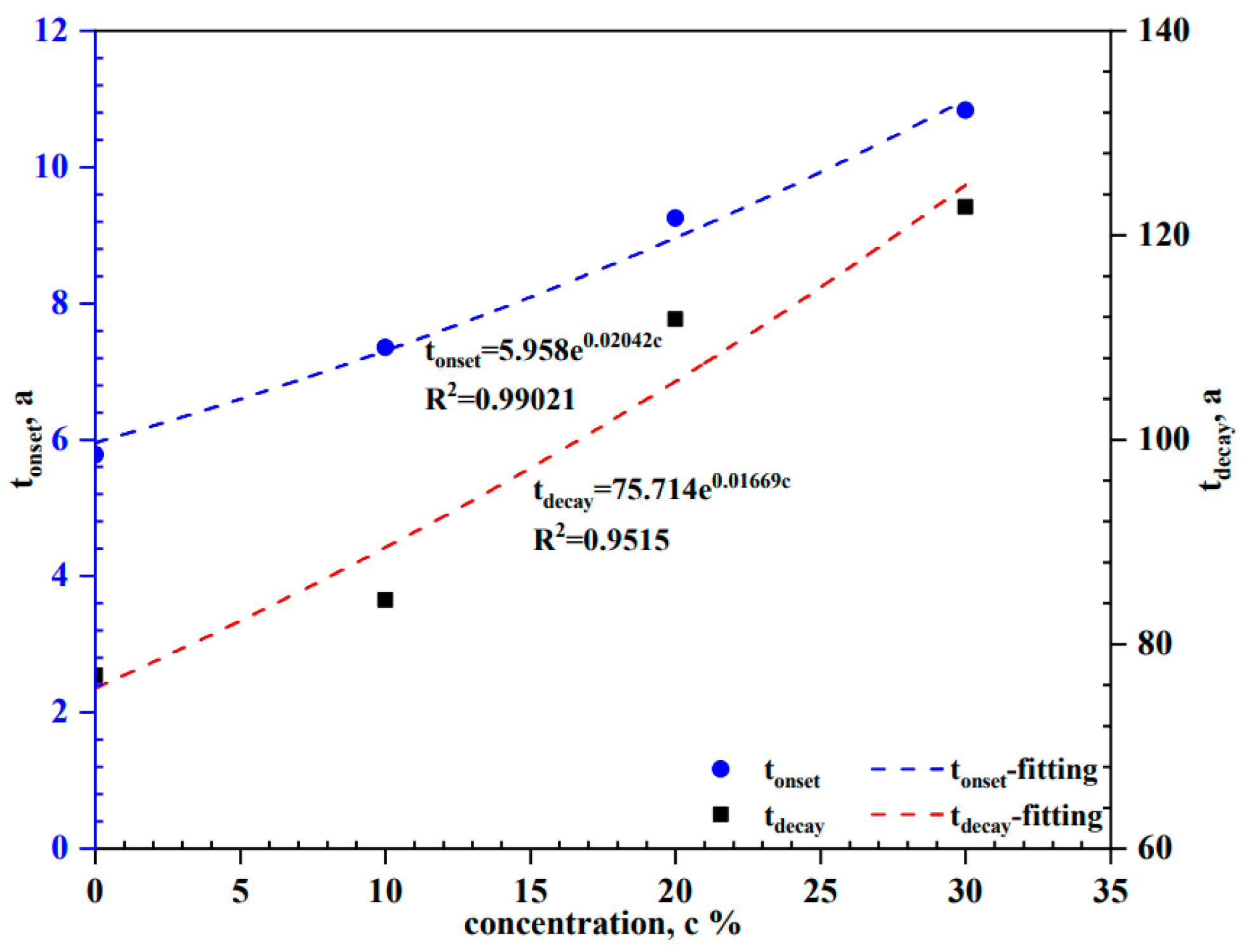







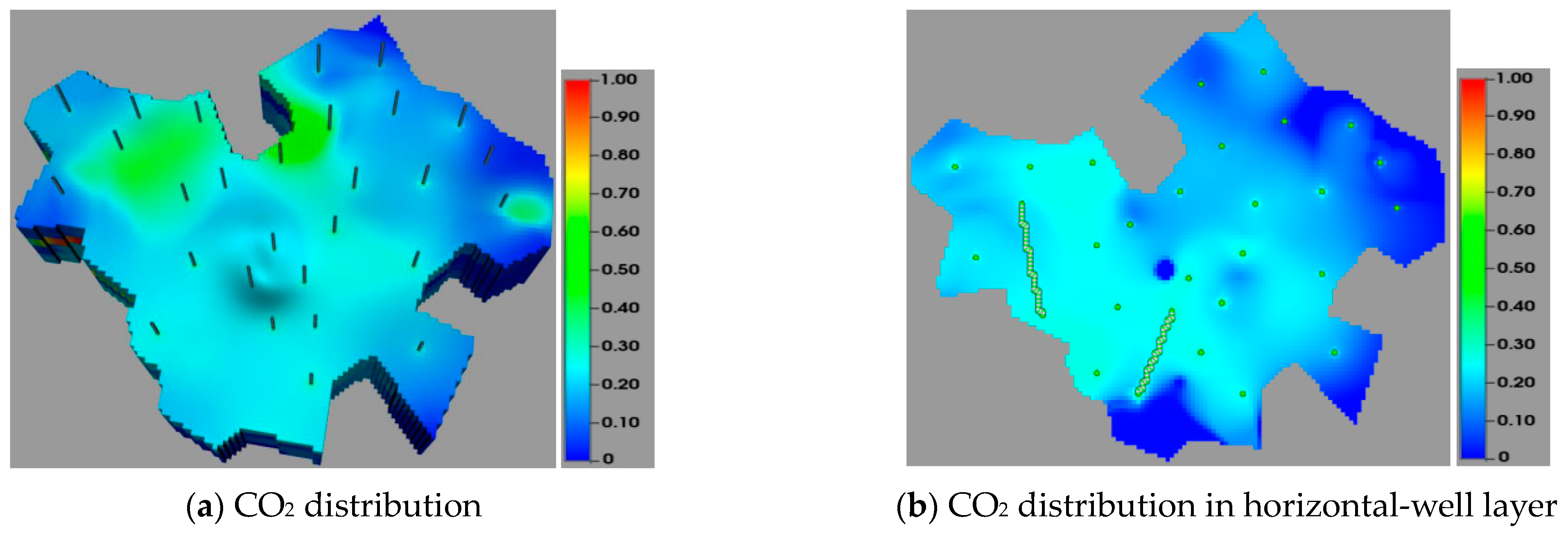

| Parameters | Case 1 | Case 2 | Case 3 | |
|---|---|---|---|---|
| Domain geometry | Top depth, m | 1500 | 1191~1432 | |
| Thickness, m | 50 | 181.8~291.7 | ||
| Dimensions of model, - | 100 × 50 | 128 × 109 × 40 | ||
| Gridblock size, m | 0.5 × 0.5 | - | ||
| Fluid properties | Phases | Single-phase | Two phases | Two phases |
| CO2 density, kg/m3 | f (state) | |||
| Brine density, kg/m3 | f (state) | |||
| CO2 viscosity, mPa·s | f (state) | |||
| Brine viscosity, mPa·s | f (state) | |||
| Diffusion coefficient, m2/s | 2 × 10−9 | |||
| Porous media properties | Permeability, mD | 300 | 0.07~2.15 | |
| Porosity, - | 0.25 | 0.005~0.054 | ||
| Residual brine saturation, Swc | 0.2 | |||
| Residual CO2 saturation, Sgr | 0 | |||
| Salinity, ppm | 30,000 | |||
| Gas end point relative permeability, krge | 1.0 | |||
| Exponent of gas relative permeability, ng | 2 | |||
| Exponent of water relative permeability, nw | 4 | |||
| Capillary entry pressure, bar | 0.2 | |||
Disclaimer/Publisher’s Note: The statements, opinions and data contained in all publications are solely those of the individual author(s) and contributor(s) and not of MDPI and/or the editor(s). MDPI and/or the editor(s) disclaim responsibility for any injury to people or property resulting from any ideas, methods, instructions or products referred to in the content. |
© 2024 by the authors. Licensee MDPI, Basel, Switzerland. This article is an open access article distributed under the terms and conditions of the Creative Commons Attribution (CC BY) license (https://creativecommons.org/licenses/by/4.0/).
Share and Cite
Lyu, X.; Cen, F.; Wang, R.; Liu, H.; Wang, J.; Xiao, J.; Shen, X. Density-Driven CO2 Dissolution in Depleted Gas Reservoirs with Bottom Aquifers. Energies 2024, 17, 3491. https://doi.org/10.3390/en17143491
Lyu X, Cen F, Wang R, Liu H, Wang J, Xiao J, Shen X. Density-Driven CO2 Dissolution in Depleted Gas Reservoirs with Bottom Aquifers. Energies. 2024; 17(14):3491. https://doi.org/10.3390/en17143491
Chicago/Turabian StyleLyu, Xiaocong, Fang Cen, Rui Wang, Huiqing Liu, Jing Wang, Junxi Xiao, and Xudong Shen. 2024. "Density-Driven CO2 Dissolution in Depleted Gas Reservoirs with Bottom Aquifers" Energies 17, no. 14: 3491. https://doi.org/10.3390/en17143491





